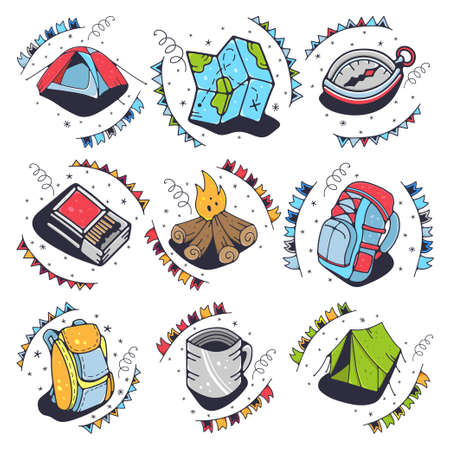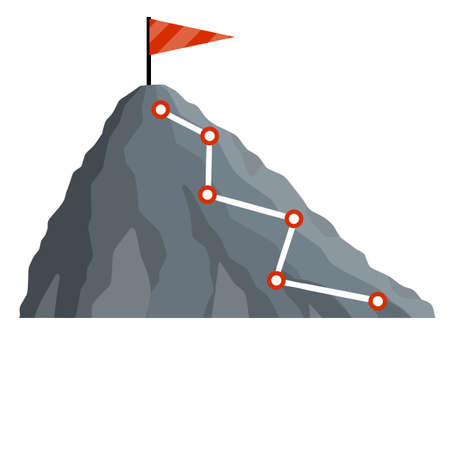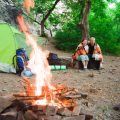Understanding Your Destination
Before you even start tossing gear into your backpack, its important to get a clear picture of where youre headed. Every destination is different, and what works for one trip might not make sense for another. Let’s break down the key things you need to check before packing:
Research the Terrain
The ground you’ll be covering can change everything about your gear list. Are you hiking through rocky mountains, lush forests, or dry desert? Here’s a quick comparison:
| Terrain Type | Recommended Gear | What to Skip |
|---|---|---|
| Mountains | Sturdy boots, trekking poles, layers for changing temps | Sandals, heavy water gear |
| Forest | Bug spray, lightweight rain jacket, breathable clothes | Excessively warm clothing in summer |
| Desert | Sun hat, extra water containers, sunscreen | Thick rain gear, insulated boots |
Understand the Climate
The weather at your destination can make or break your trip. Check the forecast before you go and look up average temperatures and rainfall for the time of year. Packing for a chilly morning that turns into a blazing afternoon? Think layers. Expecting rain? Make sure your pack has space for waterproof items.
Packing by Season Example:
| Season | Must-Have Items | Leave Behind |
|---|---|---|
| Summer | Sunscreen, lightweight clothes, hydration system | Heavy jackets, thermal underwear |
| Winter | Insulated layers, waterproof boots, gloves & beanie | Cotton shirts, open-toed shoes |
| Spring/Fall | Poncho or rain jacket, warm mid-layer, trail runners or boots depending on mud/snow conditions | Mosquito net (if bugs aren’t active), excessive cold weather gear if mild temps are expected |
Know the Local Regulations and Culture
No two places have the same rules when it comes to camping or hiking. Some parks require bear canisters; others don’t allow campfires at all. Look up permit requirements and any restrictions on gear (like drones or certain types of stoves). Also, check if there are Leave No Trace guidelines specific to the area—these details matter both for safety and being respectful to local communities.
Quick Checklist Before Packing:
- Check park or trail website for current rules and alerts.
- Look up whether you need permits for overnight stays.
- Review local wildlife concerns (bears? snakes? bugs?) and pack accordingly.
The more you know about your destination before you pack, the easier it will be to bring exactly what you need—and leave behind what you don’t.
2. Must-Have Backpacking Gear
When youre planning your backpacking adventure, packing the right gear can make or break your trip. From shelter to safety gear, heres a breakdown of what you truly need for comfort and security in the backcountry.
Shelter: Your Home Away from Home
A reliable shelter keeps you dry, warm, and protected from bugs or critters. Tents are the go-to option for most backpackers, but lightweight alternatives like hammocks or bivy sacks work too if you’re looking to save weight. Don’t forget a groundsheet to protect your tent floor from moisture and sharp objects.
Shelter Options Comparison
| Shelter Type | Pros | Cons |
|---|---|---|
| Tent | Weather protection, privacy, bug-proof | Heavier, more setup time |
| Hammock | Lightweight, comfy for sleeping, off-ground | Needs trees, less insulation in cold weather |
| Bivy Sack | Ultra-lightweight, quick setup | Tight space, minimal protection in heavy rain |
Sleep System: Rest Is Key
A good night’s sleep helps you recover after a long day on the trail. Pack a sleeping bag rated for the lowest temps you expect and a lightweight sleeping pad for insulation and comfort. In colder conditions, consider adding a sleeping bag liner or extra layers.
Sleep System Checklist:
- Sleeping bag (check temperature rating)
- Sleeping pad (inflatable or foam)
- Pillow (or stuff sack filled with clothes)
- Liner (optional for added warmth)
Clothing: Layer Up Smartly
The weather can change fast when you’re outdoors. Dressing in layers lets you adjust as needed. Avoid cotton; stick to synthetic or wool fabrics that wick sweat and dry quickly. Here’s a simple guide:
| Layer | Purpose | Examples |
|---|---|---|
| Base Layer | Wicks moisture away from skin | Synthetic or merino wool shirts/leggings |
| Insulation Layer | Keeps body heat in | Fleece jacket, puffy vest/jacket |
| Outer Layer (Shell) | Protects against wind/rain | Waterproof jacket/pants, windbreaker |
| Extras | Adds comfort/protection as needed | Hat, gloves, sun shirt, buff/bandana |
Safety Gear: Be Prepared for Anything
No one plans for things to go wrong, but it pays to be prepared. Always pack these essentials:
- Navigation: Map, compass, GPS device or app (dont rely on just your phone!)
- First-Aid Kit: Stocked with basics—bandages, painkillers, blister care, any personal meds
- Headlamp: Plus spare batteries—so you’re never left in the dark
- Fire Starter: Waterproof matches/lighter and firestarter tabs
- Knife/Multi-tool: For repairs or emergencies
- Sunscreen & Bug Spray: Protect your skin from sunburns and bites
- Whistle: For signaling if you get lost
- Trowel & Toilet Paper/Wipes: For Leave No Trace bathroom breaks
- Duct Tape: A small roll for quick fixes
- Trekking Poles (Optional): Helpful on tough terrain or steep climbs
This list covers the basics so youre set up for a safe and enjoyable trip without carrying extra weight.

3. Smart Packing Tips
How to Pack Light and Efficiently
Packing light is the golden rule for backpacking. Every ounce counts when you’re carrying everything on your back, especially on longer trails. Start by laying out all your gear, then ask yourself if you’ll truly use each item. Aim for multi-purpose tools and clothing—think a rain jacket that doubles as a windbreaker, or a pot that serves as both a bowl and mug.
Essential vs. Non-Essential Gear
| Essential | Non-Essential |
|---|---|
| Lightweight tent or tarp | Extra shoes (beyond hiking & camp sandals) |
| Sleeping bag & pad | Pillow (use rolled-up clothes instead) |
| First aid kit | Multiple books/games |
| Headlamp/flashlight | Bulky electronics (tablet/laptop) |
| Multi-tool or knife | Full-size toiletries |
| Water filter or purification tablets | Heavy camera gear (unless photography is your main goal) |
Organizing Your Pack for Comfort and Accessibility
A well-organized pack saves time and energy on the trail. Use these tips to keep your load comfortable and your essentials within easy reach:
- Heaviest items: Place close to your back and centered between your shoulder blades (think food bag, water reservoir).
- Lighter items: Stuff around heavier ones to keep things balanced (clothes, sleeping bag).
- Frequently used gear: Stash snacks, maps, sunscreen, and rain jacket in the brain (top pocket) or outer pockets for quick access.
- Compression sacks: Use them for clothes and sleeping bags to save space.
- Keep it dry: Line your pack with a trash compactor bag or use dry bags to protect against rain.
Packing Order Cheat Sheet
| Packing Zone | What Goes Here? |
|---|---|
| Bottom of Pack | Sleeping bag, sleeping pad, clothes you won’t need during the day |
| Main Compartment (center/back) | Tent, food bag, cooking gear, water reservoir/bladder |
| Sides/Outer Pockets | Tent poles, water bottles, stove fuel, rain gear, snacks, first aid kit |
| Lid/Top Pocket (“brain”) | Sunscreen, map/compass/GPS, headlamp, wallet/ID, bug spray, toilet paper/trowel |
Smart packing isn’t just about what you bring—it’s how you carry it. With these strategies, you’ll hike lighter and find what you need in seconds.
4. Leave These at Home
When you’re getting ready for a backpacking trip, it’s easy to overpack. Many beginners bring items they think they’ll need, but end up just carrying extra weight. Let’s look at some common things you can safely skip and why leaving them at home makes your hike easier and more enjoyable.
Common Items You Don’t Need
| Item | Why You Can Leave It Behind |
|---|---|
| Multiple Changes of Clothes | You only need one hiking outfit and something dry for camp. Laundry isn’t an option on the trail, and extra clothes add bulk and weight. |
| Heavy Books & Magazines | They seem like good downtime entertainment, but a single lightweight e-reader or even your phone (in airplane mode) saves space. |
| Large Toiletry Kits | Stick to travel-size basics—leave makeup, big bottles, and fancy extras at home. |
| Camp Chairs | A lightweight foam pad or using your backpack as a seat works just fine. |
| Full-Sized Towels | Packing a quick-dry travel towel is enough; regular towels are bulky and slow to dry. |
| Extra Shoes | One sturdy pair of trail shoes or boots and maybe lightweight camp shoes is all you need. |
| Canned Food & Heavy Snacks | Opt for dehydrated meals and light snacks like nuts or granola bars instead of cans or glass jars. |
| Laptop & Work Supplies | The outdoors is your chance to unplug. A phone is enough for photos or emergency contact. |
| Big Multi-Tools with Unused Features | A simple knife or small multi-tool covers most needs without added weight. |
| Pillow from Home | Your jacket or a stuff sack filled with clothes can double as a pillow. |
Tips for Lightening Your Load
- Go Minimal: Ask yourself if each item is essential for safety or comfort. If not, leave it out.
- Check the Weather: Skip rain gear if the forecast is dry, but always have a backup plan for sudden changes.
- Share Gear: If hiking with friends, split up group items like stoves or tents to save weight in everyone’s pack.
- Aim for Versatility: Choose gear that serves multiple purposes whenever possible.
5. Gear for the American Outdoors
When planning a backpacking trip in the United States, your gear choices can make or break your adventure. The American outdoors is diverse—ranging from the lush forests of the Pacific Northwest to the dry deserts of the Southwest and everything in between. Here’s how to pick gear that fits different US backcountry environments, whether you’re headed to a national park or venturing into remote wilderness areas.
Understand Your Destination
The U.S. has a wide variety of landscapes and climates. Before packing, research your specific destination:
- National Parks: Usually have marked trails, more rangers, and some facilities like water sources or bear lockers.
- Wilderness Areas: Often more rugged, fewer amenities, and require more self-sufficiency.
- Climate: Check seasonal weather—mountain nights can get cold even in summer, while deserts have extreme temperature swings.
Essential Gear Checklist for US Backpacking
| Item | Why You Need It | US-Specific Tips |
|---|---|---|
| Tent/Shelter | Shelter from rain, wind, and bugs | Select freestanding models for rocky ground; bring bug netting for summer in the Rockies or Appalachians. |
| Sleeping Bag & Pad | Stay warm and comfortable at night | Check temperature ratings; 20°F bags are common for most US locations outside mid-summer. |
| Water Filtration System | Access clean drinking water from streams/lakes | Pump filters or squeeze filters work well; always have backup purification tablets. |
| Bear-Proof Food Storage | Protect food from wildlife (bears, raccoons) | Bears are common in many parks—use approved canisters where required (like Yosemite). |
| Cook System (Stove & Fuel) | Prepare hot meals and drinks | Check fire regulations—stoves are often required over campfires during burn bans. |
| Clothing Layers | Adapt to changing weather conditions | Synthetic or wool base layers dry fast; rain jackets are a must almost everywhere. |
| Map & Compass/GPS | Navigating trails and off-trail terrain | Cell service is unreliable in many US wild areas—don’t rely only on your phone. |
| Sunscreen & Bug Spray | Protection from sunburn and insects | Ticks (Lyme disease) are a risk in the Northeast/Midwest; mosquitoes thrive near lakes/rivers in summer. |
| Trekking Poles (Optional) | Add stability on tough terrain or river crossings | Useful in steep mountain regions like the Sierra Nevada or Rockies. |
Packing Tips: What to Leave Behind
- Avoid Overpacking: Many first-timers bring too many clothes—stick to essentials and do a quick rinse at camp if needed.
- No Glass Containers: Heavy and breakable; choose lightweight plastic or metal alternatives for food storage.
- Laptop/Heavy Electronics: Enjoy unplugging; bring only necessary devices like a headlamp or GPS unit with spare batteries.
Extra US-Specific Advice:
- If hiking in grizzly country (Montana, Wyoming), carry bear spray—it’s often more important than a knife or multitool.
- If you’re going to high elevations (Colorado Rockies), pack extra snacks for energy and hydration tablets to help with altitude adjustment.
- If visiting desert areas (Utah, Arizona), plan for extra water capacity—natural sources may be scarce or dry up seasonally.
Your Takeaway Gear Strategy:
Select gear that matches not just your trip length but also regional challenges. Always check local regulations about food storage, campfires, and permits before you go. With the right setup tailored to American backcountry realities, you’ll hike safer—and have a lot more fun along the way!
6. Final Prep and Double-Check
Before you hit the trail, it’s time for a quick reality check: Do you really have everything you need, and nothing you don’t? Let’s run through a straightforward checklist and cover some last-minute tips so you can start your backpacking trip with confidence.
Backpacking Gear Checklist
| Category | Must-Haves | Leave Behind |
|---|---|---|
| Shelter & Sleep | Tent or hammock, sleeping bag, sleeping pad, lightweight pillow | Heavy air mattresses, bulky blankets |
| Clothing | Weather-appropriate layers, rain jacket, extra socks and underwear, hat | Cotton clothes, too many extras, jeans |
| Food & Water | Lightweight stove, fuel, utensils, dehydrated meals, water filter/purifier, water bottles/bladder | Canned food, glass containers, excess snacks |
| Navigation & Safety | Map/compass or GPS, first aid kit, headlamp/flashlight (with batteries), whistle | Bulky guidebooks, duplicate electronics |
| Extras | Pocket knife/multi-tool, sunscreen, bug spray, toilet paper (or wipes), trowel for digging cat holes | Full-size toiletries, heavy books or electronics |
Quick Double-Check Steps
- Test Your Pack: Put everything in your backpack and walk around your home or yard. Adjust straps for comfort. If it feels way too heavy now, it’ll feel even heavier on the trail—reconsider what’s truly essential.
- Weather Check: Look up the latest weather report for your trail area. Add or swap gear if there’s a chance of storms or cold nights.
- Food & Water Plan: Count your meals and snacks—do you have enough for each day? Double-check your water sources along the trail and make sure your filter is working.
- ID & Permits: Make sure you have any necessary permits or passes printed or downloaded to your phone. Bring ID just in case.
- Trek Tech: Charge your phone and backup battery if you’re bringing them. Download offline maps if needed.
- Tidy Up: Remove unnecessary packaging from foods to cut weight and trash. Pack out all trash bags and leave no trace supplies.
Packing Tips from Experienced Backpackers
- Pack light but smart: Focus on multi-use items when possible.
- Avoid last-minute “just in case” items: These often end up unused and only add bulk.
- Lash securely: Attach trekking poles or foam pads outside your pack if space is tight—but make sure they’re fastened well.
- Pace yourself: Don’t overpack food—most folks bring more than they eat!
- Share gear if possible: If hiking with a buddy, split up shared items like tents or stoves to save weight for everyone.
Your Pre-Trail Ritual: The 5-Minute Walkthrough
- Lay out all gear on the floor.
- Categorize by use: sleep/shelter, clothing, kitchen/food, navigation/safety, extras.
- If something doesn’t fit into a category—or feels unnecessary—leave it behind!
- Pretend you’re at camp for one night. Can you set up shelter? Cook a meal? Stay warm? If yes—you’re good to go!
- Breathe deep. You’re ready for adventure!


